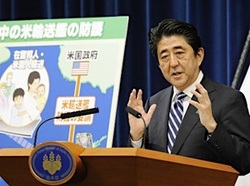 Source: nicovideo.jp
Source: nicovideo.jp However given the level of domestic opposition to Japan changing the meaning of its constitution and embarking on military operations abroad, on Monday the LDP decided to put off any debate in the Diet over the right to exercise collective self-defence until after the regional elections scheduled to take place in April and May next year. According to the Asahi Shimbun, this is because both the LDP and New Komeito need to cooperate at the regional level, and if debate at that level became centred around questions of collective self-defence, the New Komeito (whose own position on collective self-defence is yet to be firmly established) would find it difficult to support the LDP position in its current form (J).
While the so-called ‘grey zone’ elements of the collective self-defence proposal will be debated in a temporary Diet session beginning in Autumn, PM Abe appears determined to have a cabinet resolution on changing the constitution nailed down before the temporary session period begins. PM Abe has already given assurances to the US that he would have the constitutional re-interpretation in place before embarking on revitalised US-Japan security cooperation guidelines. The determination of PM Abe to enact such measures became all the more important following the election of new Indian PM Narendra Modi. As Rory Medcalf and Danielle Rajendram wrote for the Age newspaper on Tuesday, Modi, with his ‘Look East’ foreign policy, would likely wish to establish much firmer security ties with a number of states in the Indo-Pacific region, Japan being foremost among these.
The ability of Japan to exercise collective self-defence has been an issue followed closely by Australian observers, especially in light of PM Tony Abbott’s comments in Tokyo last month that essentially welcomed a more proactive Japanese military involvement in the region. While the Australian government likes to reiterate the ties of democracy and respect for rule of law that binds Japan to Australia, there is also a latent respect for Japan’s technological prowess and how this can be of use to Australia’s defence force. Japan’s military capabilities have long been debated by those inside and outside the ADF, where there is certainly recognition that Japan possesses formidable military power and would be a strong asset in any conflict. Hence the agreement between both countries to upgrade their defence relationship, for Japan, unlike other states in the region, has the logistical sophistication and technical ability to complement Australia’s own small but sophisticated military capabilities.
While other states in the region might baulk at the idea of a rejuvenated Japanese military embarking on operations overseas, Australia sees things quite differently. The degree of closeness shared by the US armed forces and Japan’s SDF represents a powerful military presence in the northern Asia and one that Australia is seeking to tap into. Combined with the emergence of an Indian government determined to expand its economy and global presence, Australia sees the potential of a regional trilateral relationship between itself, Japan and India. Such is the degree of enthusiasm of the Abbott government to cooperate with Japan, it was prepared to release only a quiet rebuttal of PM Abe’s visit to Yasukuni Shrine (in contrast to the US and EU), so as not to upset both trade negotiations and the potential for strengthening the security relationship with Japan.
For the Australian government, confirmation of the right to collective self-defence (and the release of defence technologies to those states deemed ‘acceptable’ to the Diet) cannot come soon enough (in fact, given the level of public anger directed at the Abbott government for its ‘austerity’ budget, a bit of positive news would be very welcome, one would think). While Abe (or more correctly, a joint LDP/New Komeito parliamentary committee) hammers out the minutiae of when and how Japan might be able to exercise collective self-defence, Australia is watching and waiting in anticipation of bigger things to come.
As the date draws nearer for an historic visit to Australia by PM Abe, expect far more editorials examining the nature of the relationship, specifically the ramifications of an outbreak of conflict in the East China Sea and Australia’s possible role in such a crisis. It has emerged as an issue among Australian security experts in recent years, and the implications have yet to be thoroughly examined. While most seem convinced that Australia would not play a role in any conflict in the East China Sea, or at most a very minor role, the fact that much of Australia’s exports travel through the East China Sea area means that any instability would inflict major damage on Australia’s economy. Hence stability in that area is of primary importance to Australia, and when countries start saber rattling it causes a fair degree of anguish in Canberra.
 RSS Feed
RSS Feed